2007 Kawasaki Ninja 250r Engine

Kawasaki GPX 250R / ZZR 250 / EX250 Ninja
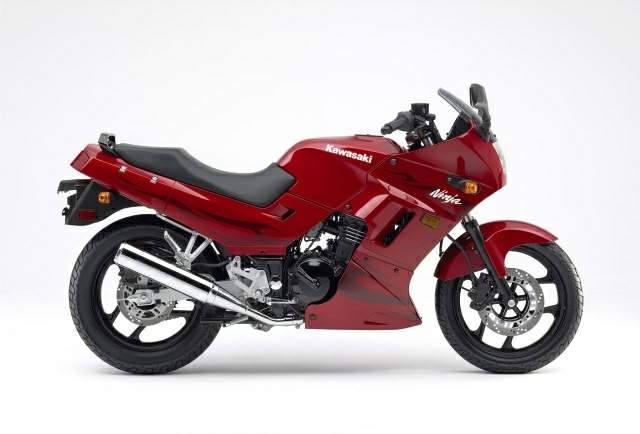
| Make Model | Kawasaki GPX 250R / EX250 Ninja / ZZR 250 |
| Year | 2006 - 07 |
| Engine | Four stroke . parallel twin, DOHC , 4 valve per cylinder |
| Capacity | 248 cc / 15.2 cu-in |
| Bore x Stroke | 62 х 41.2mm |
| Cooling System | Liquid cooled |
| Compression Ratio | 12.4:1 |
| Induction | 2x Keihin CVK30 Constant velocity, diaphragm-type |
| Ignition | Electronic advance |
| Spark Plug | NGK CR8HSA, CR8HIX, CR8HVX option CR7HSA, CR7HIX |
| Starting | Electric |
| Max Power | 45 hp / 33.5 kW @ 11000 rpm |
| Max Torque | 24 Nm / 17.7 lb-ft @ 10000 rpm |
| Clutch | Wet, multi-disc, manual, cable-actuated |
| Transmission | 6 Speed |
| Final Drive | Chain |
| Frame | Tubular diamond design |
| Front Suspension | Telescopic forks |
| Front Wheel Travel | 140 mm / 5.5 in |
| Rear Suspension | UNI-TRAK single shock |
| Rear Wheel Travel | 130 mm / 5.1 in |
| Front Brakes | Single 260mm disc |
| Rear Brakes | Single 230mm disc |
| Front Tyre | 100/80-16 |
| Rear Tyre | 130/80-16 |
| Rake | 27� |
| Trail | 84 mm / 3.3 in |
| Wheelbase | 1400 mm / 55.1 in |
| Seat Height | 740 mm / 29.3 in |
| Ground Clearance | 150 mm / 6.1 in |
| Dry Weight | 138 kg / 304 lbs |
| Wet Weight | 160 kg / 355 lbs |
| Fuel Capacity | 18 Litres / 4.7 US gal |
| Standing � Mile | 13.8 sec / 82.3 mph 132.4 km/h |
| Top Speed | 152.7 km/h / 94.9 mph |
The Kawasaki Ninja 250R (codenamed EX250; previous generations had market-specific names) is a motorcycle in the Ninja sport bike series from the Japanese manufacturer Kawasaki originally introduced is 1986. As the marque's entry-level sport bike,[1][2] the motorcycle has undergone few changes throughout its quarter-century lifetime, having received only three substantial redesigns. In some markets the Ninja 250 has been succeeded by the Ninja 300.
Since 2008, the bike is marketed as the Ninja 250R in all markets. It is also referred to by its platform designation, EX250, to which a generational suffix is attached. In the United States, previous models (EX250-E/F/G/H) were already being marketed as members of the Ninja family of sport bikes, while outside of the U.S. the bike was known variously as the ZZR-250, ZX-250, or as the GPX-250R. One of the earliest models, the EX250-C, was given the name GPZ-250.
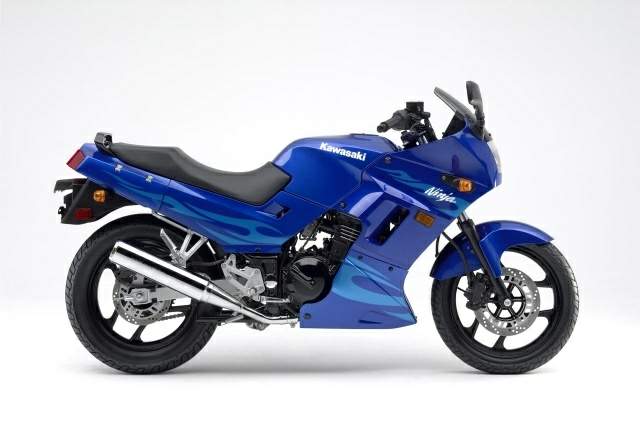
KAWASAKI NINJA� 250R GIVES SPORTBIKE PERFORMANCE ON A LIMITED BUDGET
Smallest Ninja handles better than most superbikes
The Kawasaki Ninja� 250R offers a rare combination of compact size, low purchase price and excellent performance. It continues to be among those motorcycles at the top of the sales chart. Actually, there are several reasons why consumers flock to the sporty styling of this particular motorcycle. The Ninja 250R provides easy-handling agility, a lightweight presence, and ownership costs that make this model a force to be reckoned with when shopping for a motorcycle in the entry-level sportbike category.
Power for the Ninja 250R comes from a high-revving, liquid-cooled, in-line twin-cylinder four-stroke engine featuring dual overhead cams and four valves per cylinder. It delivers smooth, predictable power that�s perfect for new motorcyclists, yet its 13,000-rpm redline and six-speed transmission will put a smile on the face of the most experienced sportbike rider. As if the Ninja�s excellent engine performance wasn�t enough, its rider will also be amazed by the nearly 70 mpg average fuel economy.
Like its larger siblings, the Ninja 250R sportbike features an aerodynamic full-fairing, Kawasaki�s UNI-TRAK� progressive rear suspension and high-performance disc brakes. It also has a low seat height for added confidence when stopped. Other features include an easy-to-read instrument panel, positive neutral finder, centerstand and pop-up bungee hooks.
FEATURES:
Twin-cylinder 248cc Engine
- Compact parallel-twin design is lightweight and high revving, with a broad torque curve
- Good mass centralization for superior handling
Liquid Cooling
- Maintains consistent engine temperatures for long engine life and sustained power
- Allows tighter engine clearances for increased power and quieter running
Four Valves per Cylinder
- Provides maximum valve area for optimum flow to boost low end torque while providing better breathing for more power at high rpm
High Velocity Induction Technology
- Provides a smooth flow of air to the carburetors for maximum top-end
- Carburetor and intake port diameters are sized for quick mid-range throttle response
Silent Cam Chain
- Low friction coating on chain guides reduces wear, increases power
- Runs quietly, reliably
- Automatic cam chain tensioner maintains precise timing without maintenance
Six-speed Transmission
- Allows engine�s full potential to be used
- Provides excellent acceleration as well as relaxed highway cruising
Positive Neutral Finder
- A Kawasaki exclusive, just lift the pedal from first at a stop to find neutral easily
Bottom-link UNI-TRAK� Rear Suspension
- Lowers the center of gravity for better handling
- Progressive rate provides a smooth, controlled ride
Handlebar Mounted Choke
- Convenient location makes starting and warm-up easier
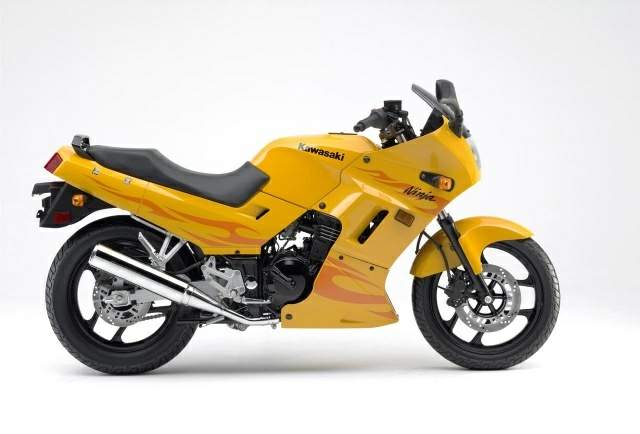
Diamond Frame
- Lightweight, high-tensile steel for amazing rigidity
- No down tubes for lower engine placement and lower center of gravity
- Good ground and cornering clearance
Dual-Piston Front Brake
- Balanced actuation caliper front disc brake for excellent feel and long pad wear
Dual-Piston Rear Disc Brake
- Powerful, reliable, controllable stopping power
Centerstand and Sidestand
- Permits easy parking, cleaning or servicing
4.8-gallon Fuel Tank
- Long range makes it great for commuting
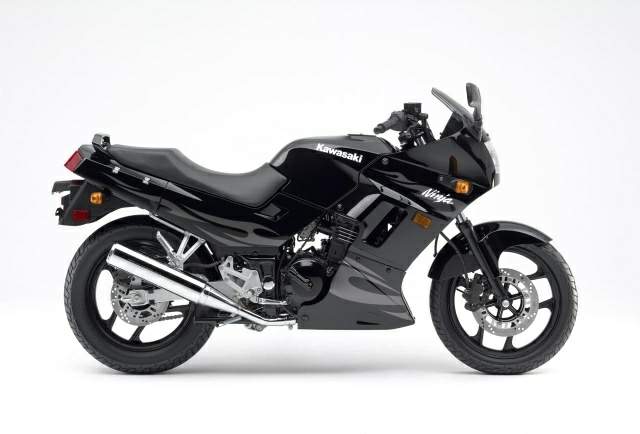
Review
lo-band | hi-band LOS ANGELES, December, 1997 -- You've got to start somewhere. And just as new pilots aren't strapping themselves into multi-engine jets, beginning riders are ill-advised to start their career with their legs wrapped around a GSX-R750 or a Gold Wing.
New riders need to get a feel for it all: The wind, the road, the speed. But it's got to be fun, too, and while you're learning the intricacies of choosing a line through a decreasing radius turn, or just learning to stay the hell out of the way of the insipid nut who's changing lanes right into you, you still want a bike that reflects your personality, accommodates your riding habits and will help you become a skilled rider. Motorcycle Online decided to put three "beginner" bikes through their paces in an effort to find motorcycle-Nirvana for the novice.
Our test bikes were the Kawasaki Ninja 250R, the Yamaha Virago 250, and the Honda CB250 Nighthawk. We couldn't have found three bikes in the same displacement category that were less like each other. What they did have in common was our main testing criteria: Lightweight, small-displacement, cheap.
The Ninja is driven by a 248cc liquid-cooled parallel twin. The short 41.2mm stroke is reflected in the 14,000 rpm redline that is indicated on the only tach present among the three bikes. With dual-disc brakes, a compliant suspension, and a six-speed gearbox shifting through a reasonably good power curve, the smallest Ninja of the family just barely edged out the Virago in our test.
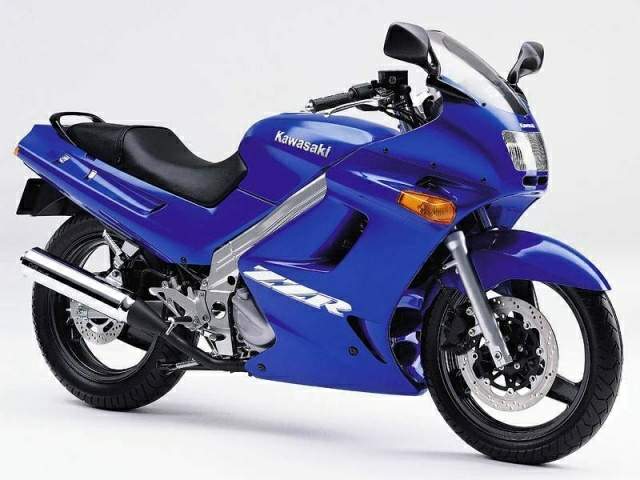
Which brought us to a surprising discovery: The Virago is a kick-butt little cruiser, designed and styled to fulfill its particular special mission. Sporting nice metallic paint, cool forward controls and wide handlebars, riding the Virago certainly didn't look any different from riding any other cruiser, except that it is a bit smaller (and therefore a fraction of the weight). For the rider, though, the real pleasure started at the right wrist with the best power delivery and most sensitive throttle control of the group, by far. The 249cc air-cooled V-twin packed about as much torque as possible into those two little lungs and twisting the grip resulted in a pleasantly smooth and insistent tug while floating along on the soft but capable suspension. Top that off with a low seat height and a long wheelbase for a fine expressway cruise and you've got a fine trainer that nearly ate the whole enchilada but for one detail that, alas, is fairly crucial to first-time riders: Price. Resting your behind on the Yamaha's comfy seat will suck a full $1,000 more out of your bank account than will the Ninja. And, though the Ninja had some very real problems (more on those in a moment), it would be hard to argue in a straight 1-2-3 comparo that the Virago was $1,000 finer, especially for a bike that is destined to be replaced when the rider is ready for bigger, badder, faster.
But what about Contestant Number Three? Well, the 250 Nighthawk was definitely there, we rode it, and we, alas, did not see the light. The excellent 750 Nighthawk's little brother came off more like the stunted child than a chip off the ol' block, with a power delivery that one of our testers precisely described as "ridiculously low", even for a 250. A standard should be built with all-around competence in mind, but with cheesy 70's-styled controls and switches, a suspension that left us wondering whether this bike's designers had ever heard of or had just completely forgotten damping of any kind, and finally a front drum brake, we were left scratching our heads. Buying into this would only cost you $400 more than the Ninja. Hmm.
Well, a sunny Friday afternoon sun beckoned and we strapped on some lids, slapped on some gloves, and took these bikes out for a spin in the Malibu Canyons. Tests can not live on commuting alone. Twisties must be negotiated to unlock a bike's inner truths.
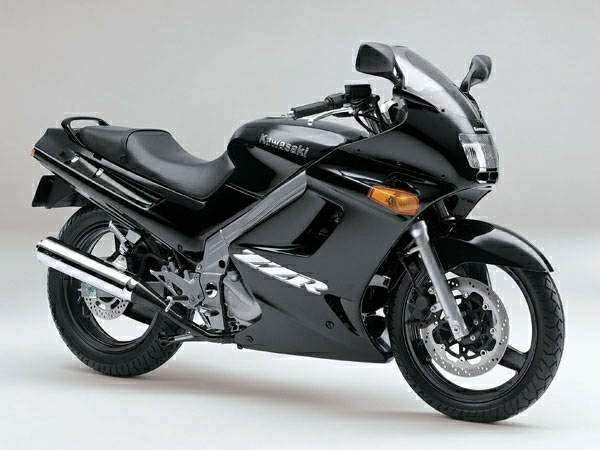
The Ninja devoured the winding asphalt with aplomb. A light, sporty 250 should turn like a French curve, and so the Ninja did, with fine braking into the turns supplied by a twin-piston caliper gripping the rotor up front, and a single piston binder grabbing a disc at the rear. Stoppies are possible on this motorcycle. And just like a sportbike should be, the Ninja was the essence of flickable and, more importantly for a beginner, confidence inspiring, holding on to most lines asked then coming out of the corners into a surprisingly stable ride.
There were perhaps a few other surprises, not quite as welcome. Low to mid-rpm carburetion was glitchy at best and the bike was at times a little unsettled when driven deep into the corners. Where the Virago's perceived power delivery was in a nice smooth curve, the Ninja was marred with uneven and sluggish off-idle power until about 5,000 rpm where things started to smooth out a bit. Furthermore, drive lash on this bike was quite significant, and while it could be argued that it would encourage newbies to learn smooth throttle control, the overall effect was rather unpleasant, and a sudden throttle change in a turn (not unreasonable to expect for a new rider) could be an unsettling sensation indeed, despite the rather soft suspension set-up.
The Virago suffered no such nonsense, simply responding as expected to minute throttle adjustments, flicking nicely into the corners and offering a ride that, although soft, was pretty much exactly what you'd want from a cruiser. Ground clearance wasn't great and scraping pegs wasn't difficult, but then this is a cruiser and wasn't out of character.
Our Nighthawk was, well, again, the least fun of the three.
With what seemed like zero front end dampening and springs at both ends that were much too soft, flying through the kinks in the road became more a matter of slowing the hell down and just cruising, nice and easy. Except that it isn't a cruiser and there is a zero cool factor. The Honda also suffered from a great gaping lag on the throttle coming off idle, and a very uneven idle at that. We just couldn't see this little standard beckoning to the beginner for that Sunday morning out on the road. It was no fun in the turns and offered none of the general do-it-all capability that a standard should. And where the Virago sported a single disc up front and the Ninja had discs front and back, the Honda had that darn front drum brake. Braking was okay on the Nighthawk, but given Honda's reputation for details, we would like to see them at least pretend they cared.
The choice for us was clearly between the Ninja and the Virago, and we did come to a split. We were all impressed by the Virago's refinement, not only in the quality of the feel but also in the appearance and quality of the fit and finish. It not only accepted its cruiser role, but it fulfilled it very nicely, with no apologies for displacement. Unfortunately, it also did so with no apologies for price, and this is where the Ninja made up for its shortcomings. The cheapest of the three, the Ninja offered true sportbike capability and styling along with a good fit and finish, lots of little features like bungee hooks, centerstand, a tachometer, front and rear disc brakes and an all-around fun time. Of course, given the disparity of styling a choice between the two might come down to simple riding preference, sport or cruising, and either choice would give a novice a good platform to grow on and, most importantly, avoid that aforementioned nut inviting himself into your lane.
Source Motorcycle.com
Review
lo-band | hi-band LOS ANGELES, December, 1997 -- You've got to start somewhere. And just as new pilots aren't strapping themselves into multi-engine jets, beginning riders are ill-advised to start their career with their legs wrapped around a GSX-R750 or a Gold Wing.
New riders need to get a feel for it all: The wind, the road, the speed. But it's got to be fun, too, and while you're learning the intricacies of choosing a line through a decreasing radius turn, or just learning to stay the hell out of the way of the insipid nut who's changing lanes right into you, you still want a bike that reflects your personality, accommodates your riding habits and will help you become a skilled rider. Motorcycle Online decided to put three "beginner" bikes through their paces in an effort to find motorcycle-Nirvana for the novice.
Our test bikes were the Kawasaki Ninja 250R, the Yamaha Virago 250, and the Honda CB250 Nighthawk. We couldn't have found three bikes in the same displacement category that were less like each other. What they did have in common was our main testing criteria: Lightweight, small-displacement, cheap.
The Ninja is driven by a 248cc liquid-cooled parallel twin. The short 41.2mm stroke is reflected in the 14,000 rpm redline that is indicated on the only tach present among the three bikes. With dual-disc brakes, a compliant suspension, and a six-speed gearbox shifting through a reasonably good power curve, the smallest Ninja of the family just barely edged out the Virago in our test.
Which brought us to a surprising discovery: The Virago is a kick-butt little cruiser, designed and styled to fulfill its particular special mission. Sporting nice metallic paint, cool forward controls and wide handlebars, riding the Virago certainly didn't look any different from riding any other cruiser, except that it is a bit smaller (and therefore a fraction of the weight). For the rider, though, the real pleasure started at the right wrist with the best power delivery and most sensitive throttle control of the group, by far. The 249cc air-cooled V-twin packed about as much torque as possible into those two little lungs and twisting the grip resulted in a pleasantly smooth and insistent tug while floating along on the soft but capable suspension. Top that off with a low seat height and a long wheelbase for a fine expressway cruise and you've got a fine trainer that nearly ate the whole enchilada but for one detail that, alas, is fairly crucial to first-time riders: Price. Resting your behind on the Yamaha's comfy seat will suck a full $1,000 more out of your bank account than will the Ninja. And, though the Ninja had some very real problems (more on those in a moment), it would be hard to argue in a straight 1-2-3 comparo that the Virago was $1,000 finer, especially for a bike that is destined to be replaced when the rider is ready for bigger, badder, faster.
But what about Contestant Number Three? Well, the 250 Nighthawk was definitely there, we rode it, and we, alas, did not see the light. The excellent 750 Nighthawk's little brother came off more like the stunted child than a chip off the ol' block, with a power delivery that one of our testers precisely described as "ridiculously low", even for a 250. A standard should be built with all-around competence in mind, but with cheesy 70's-styled controls and switches, a suspension that left us wondering whether this bike's designers had ever heard of or had just completely forgotten damping of any kind, and finally a front drum brake, we were left scratching our heads. Buying into this would only cost you $400 more than the Ninja. Hmm.
Well, a sunny Friday afternoon sun beckoned and we strapped on some lids, slapped on some gloves, and took these bikes out for a spin in the Malibu Canyons. Tests can not live on commuting alone. Twisties must be negotiated to unlock a bike's inner truths.
The Ninja devoured the winding asphalt with aplomb. A light, sporty 250 should turn like a French curve, and so the Ninja did, with fine braking into the turns supplied by a twin-piston caliper gripping the rotor up front, and a single piston binder grabbing a disc at the rear. Stoppies are possible on this motorcycle. And just like a sportbike should be, the Ninja was the essence of flickable and, more importantly for a beginner, confidence inspiring, holding on to most lines asked then coming out of the corners into a surprisingly stable ride.
There were perhaps a few other surprises, not quite as welcome. Low to mid-rpm carburetion was glitchy at best and the bike was at times a little unsettled when driven deep into the corners. Where the Virago's perceived power delivery was in a nice smooth curve, the Ninja was marred with uneven and sluggish off-idle power until about 5,000 rpm where things started to smooth out a bit. Furthermore, drive lash on this bike was quite significant, and while it could be argued that it would encourage newbies to learn smooth throttle control, the overall effect was rather unpleasant, and a sudden throttle change in a turn (not unreasonable to expect for a new rider) could be an unsettling sensation indeed, despite the rather soft suspension set-up.
The Virago suffered no such nonsense, simply responding as expected to minute throttle adjustments, flicking nicely into the corners and offering a ride that, although soft, was pretty much exactly what you'd want from a cruiser. Ground clearance wasn't great and scraping pegs wasn't difficult, but then this is a cruiser and wasn't out of character.
Our Nighthawk was, well, again, the least fun of the three.
With what seemed like zero front end dampening and springs at both ends that were much too soft, flying through the kinks in the road became more a matter of slowing the hell down and just cruising, nice and easy. Except that it isn't a cruiser and there is a zero cool factor. The Honda also suffered from a great gaping lag on the throttle coming off idle, and a very uneven idle at that. We just couldn't see this little standard beckoning to the beginner for that Sunday morning out on the road. It was no fun in the turns and offered none of the general do-it-all capability that a standard should. And where the Virago sported a single disc up front and the Ninja had discs front and back, the Honda had that darn front drum brake. Braking was okay on the Nighthawk, but given Honda's reputation for details, we would like to see them at least pretend they cared.
The choice for us was clearly between the Ninja and the Virago, and we did come to a split. We were all impressed by the Virago's refinement, not only in the quality of the feel but also in the appearance and quality of the fit and finish. It not only accepted its cruiser role, but it fulfilled it very nicely, with no apologies for displacement. Unfortunately, it also did so with no apologies for price, and this is where the Ninja made up for its shortcomings. The cheapest of the three, the Ninja offered true sportbike capability and styling along with a good fit and finish, lots of little features like bungee hooks, centerstand, a tachometer, front and rear disc brakes and an all-around fun time. Of course, given the disparity of styling a choice between the two might come down to simple riding preference, sport or cruising, and either choice would give a novice a good platform to grow on and, most importantly, avoid that aforementioned nut inviting himself into your lane.
Source Motorcycle.com
2007 Kawasaki Ninja 250r Engine
Source: https://www.motorcyclespecs.co.za/model/kawasaki/kawasaki_ninja_250r.htm








Tidak ada komentar:
Posting Komentar